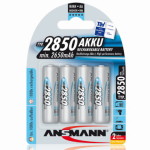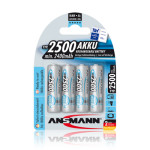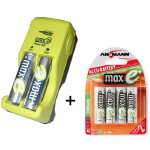Three Things You Need To Know About Rechargeable Batteries
By David Schliep
About David Schliep
David Schliep has over 15 years experience with rechargeable technology. He has personally assisted over 25,000 families, schools, churches, theaters, and production facilities convert to rechargeables so they can save money and help save the planet from toxic battery waste. Just last year, David converted the Katy Perry Prismatic World Tour to rechargeables for their wireless mics and in-ear monitors. Other clients include Cirque du Soleil, Blue Man Group, and Nine Inch Nails.

-
1
Understanding Your Electronics
First and foremost, you need to understand the different types of electronics you have so you can decide what type of rechargeable batteries to use
Everything depends on what you are trying to achieve with rechargeable batteries. How do you plan to use them? More importantly, what are the specifics of your portable electronic devices? Let's explore some of the common ways to effectively use rechargeable batteries.
- High drain devices. Wireless microphones, in-ear monitors, flash units, digital cameras, CD and MP3 players and other high-drain devices all work just fine with rechargeable batteries. In fact, rechargeable batteries are preferred because of their faster recovery times between power use (such as a flash unit.) Many times, the overall strength or capacity (known as milli-amp hours or mah) is much higher than a standard alkaline battery. Some other examples of high-drain devices are portable fans, paintball guns and hoppers, and portable TV's.

- Low drain devices. Not many people realize that devices such as smoke detectors, wireless mouse and keyboards, video game controllers and remotes can also utilize rechargeable batteries. Personal electronics such as hair trimmers and electric toothbrushes, as well as thermostats, penlights and LED lamps can all use rechargeables. Typically, these devices do not draw a large amount of current and are used intermittently. With the advances in rechargeable technology, just about any household item that uses AA, AAA, 9V, C or D's can be powered by rechargeables.
- Know your run-time requirements. To properly choose the right rechargeable system, you will need to know the run-time requirements of your wireless devices. For example, you may need to run a wireless microphone for 2 hours or 12 hours per use. It may be used daily or once a week. A digital camera may be used professionally everyday for 4 - 6 hours or a couple hours twice a month for personal consumption.
- The Dormancy Factor -- how long does the device sit idle in stand-by? A video game controller may be used for 2 hours but only once a week. Knowing your usage pattern is important so you can choose the right type of batteries for your device.
- Are they portable? Are your electronics stationary or on-the go? Is it important to be portable when considering a charging unit? Understand your pattern of usage and run-time requirements so you can choose the best charger and minimize frustration.
- Finally, consider what you are spending a year on throw-away batteries. Is it $50 or $5000? When we switched all the Cirque du Soleil touring and resident shows over to rechargeables, they were spending over $1000 per week in disposable batteries. Talk about saving money! In contrast, a church or school facility may spend upwards of $1000 per year. Even most families spend an average of $150 -$200 per year. That adds up to over $10,000 in a lifetime. Have you ever considered where else you could be spending that 10K instead of throw-away batteries?
Your first assignment, is to compile a list of all your wireless gear and classify it by low-drain or high-drain and by battery size. Also jot down a note about your usage pattern for each device. You'd be surprised how many batteries you use in your facility or household. Find out know how many batteries you really use so you can easily choose the right charger.
Download our helpful battery checklist below so you can complete this quickly and easily.
Get A Free Personal Battery Kit
Try Our Batteries For FREE. It's a great way to 'test' our batteries to see if they will work with your electronic devices. Theses batteries are excellent for remotes, wireless keyboards, solar lights, LED lights, and a host of other personal ' low-drain' devices we've discussed above. Offer includes simple, overnight plug-in charger and 4 high power, low discharge AA batteries.

-
2
Choosing The Right Batteries
If you get this part right, you're halfway home.
Now that you've understand the difference between high and low-drain devices, let's learn a little about the different types of rechargeable batteries so you can perfectly match the right batteries with your gadgets.
- Batteries for high-drain devices. For electronic devices such as wireless mics, in-ear monitors, flash units, portable fans, etc., always use the highest capacity batteries available. Even if your run-time requirements are minimal, high-drain devices are best handled by high-capacity cells. Since high-quality cells do not have memory effect, it does not matter if you use the device for 2 hours or 12 hours.
As an example, if you need AA's this means choosing a battery like the Ansmann 2850 mah cells.
 Ansmann cells are not only high capacity, but have high recycles. Obviously, you'll save more money by purchasing a high capacity battery that allows up to 1000 recharges. It makes no sense to skimp on an inferior brand that touts high capacity but can only deliver for 50 recycles. You're needlessly throwing money -and batteries- away.
Ansmann cells are not only high capacity, but have high recycles. Obviously, you'll save more money by purchasing a high capacity battery that allows up to 1000 recharges. It makes no sense to skimp on an inferior brand that touts high capacity but can only deliver for 50 recycles. You're needlessly throwing money -and batteries- away.
Likewise, For AAA's, use Ansmann 1100 mah cells.
For C and D cells, use the Ansmann C 4500 mah and D 10,000 mah cells.
For a list of high-capacity batteries, visit the downloads and links section below
For high-drain devices that use 9V's, you have two options: If your run-time requirements are less than 4 hours, choose the standard Ansmann 300 mah cell. For longer run-times and extremely high-drain 9V devices, utilize the Hi-Tech 9V lithium ion rechargeable cell. These batteries are rated at 600 mah and can achieve run-time applications for over 15 hours depending upon the drain of the device. However, the number of recycles are less than that of the Ansmann 300 mah.
- Batteries for Low-drain devices. Use batteries like the Ansmann Max-E low self-discharge (LSD) batteries if your portable electronics are dormant for more than a few days.
 An example of this would be a wireless mouse or keyboard. Even if you use your computer everyday, the drain on the battery is minimal and, unless you're an online junkie, the keyboard and mouse sits dormant for hours at a time. Another LSD example would be the TV and/or Cable remote. Sure, you may channel surf for a few hours, but eventually the remote just sits there. Flashlights may only be used once a month. The same holds true for a hair trimmer that's used once a week. Smoke detectors, hearing assist devices, nursery pagers, pre-amps, effects pedals, and LED reading lamps, are all examples of devices that would use LSD effectively. Using the LSD batteries assures there will be power on demand - for up to one year! Ansmann Max-E batteries are available in all standard sizes, and are slightly less in total capacity the the high-capacity batteries.
An example of this would be a wireless mouse or keyboard. Even if you use your computer everyday, the drain on the battery is minimal and, unless you're an online junkie, the keyboard and mouse sits dormant for hours at a time. Another LSD example would be the TV and/or Cable remote. Sure, you may channel surf for a few hours, but eventually the remote just sits there. Flashlights may only be used once a month. The same holds true for a hair trimmer that's used once a week. Smoke detectors, hearing assist devices, nursery pagers, pre-amps, effects pedals, and LED reading lamps, are all examples of devices that would use LSD effectively. Using the LSD batteries assures there will be power on demand - for up to one year! Ansmann Max-E batteries are available in all standard sizes, and are slightly less in total capacity the the high-capacity batteries.
For a list of low-discharge batteries, visit the downloads and links section below
- Here is the Key. Remember the higher the capacity (or mah) the longer the run-time. High-capacity cells have longer -run-times -- but -- also experience self-discharge -- -about 2% per day. What this means if you leave an Ansmann 2850 mah AA battery in a digital camera for one week, you'll lose at least 10% of available power just by virtue of "self-discharge. For this reason, high capacity cells need to be kept in a quality battery charger on "trickle charge" until their next use. (I'll cover that in the final section) So, for devices that are left dormant, in stand-by, I recommend Ansmann Max-E LSD batteries.
- High recycles mean more savings. Always choose batteries with the highest recycles available. Check the brand reputation. Cirque du Soleil, Katy Perry, and Blue Man Group as well as 25,000 families, schools, churches and theaters all use the Ansmann brand for a reason - they work! Not just 50 times, but up to 1000 times - year after year. Again, the purpose of switching to rechargeables is to save money. The more recycles achievable, the more bang for your buck.
In the next and final step, we'll explore the heart of your rechargeable system - the battery charger and maintenance device. Stay tuned.
Try Before You Buy
Why is this Free? I want you to experience first hand how good our batteries perform before you commit to converting to rechargeables. Try this 'starter' kit first so you can see for yourself. Once you're ready, I'll show you how to get a complete rechargeable system at the best value.

-
3
Maximizing Your Recharging System
The battery charger is the "heart" of your rechargeable system. Learn more about them so you can pick the best one for you.
Equally important as the correct rechargeable battery is the proper battery charger. You don't want to ruin great batteries with a bad charger. Let's take a look at the battery charger options.
- Determine if you want to use a universal, high capacity centralized charging unit or several portable units or both. Most avid users of rechargeable batteries wind up using a combination of both.
Here's a few examples:
Suppose your facility is a church with 12 AA wireless microphones, four 9V in-ear monitors, 5 listening assistance devices that use AA's, and 10 LED lamps that use AAA's. Obviously, this application will require a few high-capacity chargers that can charge multiple types of cells.
Perhaps you're a family of four with a new baby. You need a charger that will handle AA's for the digital camera and baby monitor, C batteries for the baby swing, AAA's for the TV remote and wireless headphones, and a collection of C' and D's for the toys and games. It would make more sense to go with a universal charger too, but you may want a small portable charger as well for on-the-go charging.
A professional photographer may want an extremely fast AA charger for flash units, but still need portability for on-location. Ansmann offers quality battery chargers for every application.
If you haven't done so already, you can still download the "device list" below. Now's a good time to add all the batteries up and figure what charger(s) is/are best for you. Depending on how many batteries you need to charge, we can charge as little as two batteries and as many as 16 with a single charging unit.
Below you'll find a link to a list of recommended battery chargers
- Next, make sure the charger is "intelligent" and automatically switches to "trickle" charge when the batteries are completely charged. This will maintain the batteries in a topped-off condition and prevents over-charging which shortens the battery life and recycles. The charger should not overheat the batteries. Many chargers on the market today that are dubbed as "fast chargers" overheat the batteries and shorten their life. Ansmann chargers, even the super-speed chargers all have over-heat protection to make sure batteries remain at an optimal temperature while charging.
- For best results, choose a battery charger that offers refreshing or reconditioning of the cells. Ansmann Energy 8+ and 16+ chargers both feature an automatic refresh cycle which keeps the battery chemistry at optimal balance. This assures long run-times and higher recycles. Other chargers do not provide this benefit . And, although Ansmann cells do not have a memory effect, after years of service all nickel metal hydride cells (NiMH) develop chemistry imbalances that need to be corrected for optimal battery life. The refresh function on the Energy 8+ and Energy 16+ will maintain your batteries providing you with the greatest battery life.
- Here's a little recharging tip: Do not try to run the batteries completely dry. We've all been accustomed to squeezing the most out our throw-away alkalines. You do not have to do this with your Ansmann rechargeables. They do not develop memory effect. Whether you use the battery for 2 hours or 12, return it to the charger and get it ready for the next use.
- Finally, consider extra batteries. Instead of having a huge pile of throw-aways, reduce your extra batteries to a few spares or at most a second set. This is true whether you use standard rechargeables, or LSD cells, or both. Always have a few spares. Isn't it much more convenient to have a few extra batteries just sitting on the charger instead of scrounging around for a random battery in the junk drawer?
I hope you have enjoyed this primer on rechargeable systems. Check out our offer below for the Ultimate Money-Saving Battery Kit. This special offer allows you to customize your charger with exactly the right batteries you want. If you’re still not sure what is best, I can help. Visit the link below for help in customizing your rechargeable battery system.
And of course, you’re always welcome to “test” our batteries by ordering the FREE Personal Battery Kit. You pay for shipping only.
Happy recharging!